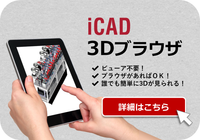[Case Study of 3D CAD Software for Mechanical Design] Hokos Co., Ltd.
[Free Case Studies Provided] Revamping the design environment to reduce design errors! Steering towards expanded utilization.
We would like to introduce a case study of the implementation of "iCAD SX" at Hokos Co., Ltd., which specializes in the design and manufacturing of machine tools. The primary goal of the implementation was to reduce design errors, addressing issues such as forgetting to correct side views after fixing floor plans, and mistakes in numbering when adding new parts during reuse design. Ultimately, the product was chosen for its fast startup and drawing speed, the ability to use 3D and 2D in sync, and the capability to design with just 2D. 【Case Overview (Partial)】 ■ Background of Implementation - 3D CAD is essential for future design - Designers in Japan are finding it increasingly difficult to grasp the three-dimensional image from 2D drawings - The current 2D CAD lacks the potential for development into 3D - Reduction of design errors *For more details, please refer to the PDF document or feel free to contact us.
basic information
【Overview of Other Cases】 ■Consideration Conditions - Ability to utilize 1.1 million drawings created with past 2D CAD - Designers can learn the operation methods without affecting regular business operations - Scalability to adapt to future changes in usage, such as product operation simulations *For more details, please refer to the PDF materials or feel free to contact us.
Price range
Delivery Time
Applications/Examples of results
For more details, please refer to the PDF document or feel free to contact us.
catalog(1)
Download All CatalogsRecommended products
Distributors
To support Japan's manufacturing, iCAD Corporation has developed the specialized 3D CAD software 'iCAD SX V8' focused on mechanical design. iCAD achieves high-speed response, handling 3 million parts in just 0.2 seconds, allowing for stress-free design consideration and verification of large-scale equipment and entire production lines that can consist of tens of thousands of components. By leveraging its ability to manage vast amounts of information, it is possible to accumulate and utilize the design information necessary for equipment development, including piping, wiring, and control (movement), all within a single CAD data set. This single data set can be used across various scenarios and departments, from design to manufacturing, assembly, and maintenance. This leads to a reduction in development lead time and an improvement in design quality.










